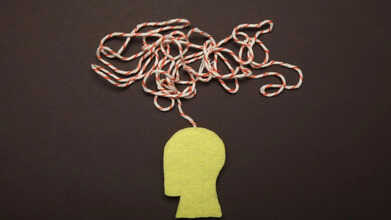- Health Conditions A-Z
- Health & Wellness
- Nutrition
- Fitness
- Health News
- Ayurveda
- Videos
- Medicine A-Z
- Parenting
- Web Stories
If You Read Books Before Bed THIS Way, You Could Be Inviting Early Dementia

Credits: Canva
Most of us have our little rituals before sleep. Whether it is applying a face mask, scrolling through Instagram, or reading a book we have been engrossed in for a while, we all have our rituals before bedtime. But there is one version of bedtime reading that could be quietly affecting your brain’s long-term health.
The Tablet Trap
Experts say the blue-white light from these devices is tricking your brain into thinking it is still daytime. That light suppresses melatonin, the hormone that tells your body to sleep. Without enough melatonin, your circadian rhythm, basically your internal clock, goes haywire. And when your body clock is off, so is your sleep quality.Science Has Receipts
This is not just a “some people feel tired” situation. A study found that people who read on tablets before bed showed measurable changes: their melatonin levels dipped, they took longer to doze off, they missed out on precious REM cycles, and they felt groggy the next morning.Another study clocked that just two hours of evening screen reading significantly delayed melatonin release, with higher brightness levels making things worse. The everyday “normal” routine of winding down with a glowing screen may be programming you for long-term trouble.
From Poor Sleep to Dementia Risk
Sleep is not just beauty rest; it is brain housekeeping. During deep and REM sleep, your brain consolidates memories, clears toxic waste products, and essentially resets itself for the next day.Long-term disruption to this process has dire consequences. The Whitehall II study, which followed nearly 8,000 adults over three decades, found that middle-aged people consistently sleeping six hours or less had about a 30 per cent higher chance of developing dementia later in life.
In other words, if you are routinely cheating your brain of quality sleep, you are upping the odds that cognitive decline will come knocking sooner than you would like. Add to that the fact that tablet use specifically causes fragmented REM sleep, and suddenly your bedtime routine doesn’t look so relaxing after all.
Better Bedtime Habits
You do not need to give up reading. You just need to swap pixels for something kinder on your body clock.- Paper is your friend: Old-fashioned paperbacks and hardcovers don’t emit brain-confusing light. Your book might weigh more than a Kindle, but your neurons will thank you.
- Audiobooks to the rescue: Prefer tech? Use it wisely. Download an audiobook or switch on a podcast with your device’s screen turned off.
- Declare a screen curfew: If you must use a tablet, dim the brightness, enable night mode, hold it farther from your face, and put it down at least an hour before bed.
- Light it right: A soft bedside lamp behind your shoulder beats the harsh glare of a backlit screen. Go for warm, amber-toned bulbs.
- Make your room a cave: Blackout curtains, eye masks, and hiding any blinking chargers will help keep your sleep sanctuary truly dark.
It is not about what you are reading, whether it is the latest bestseller, a dusty classic, or guilty-pleasure fan fiction. The problem lies in how you are reading it. Backlit tablets may feel modern and convenient, but the long-term cost of disrupted sleep could be a sharper risk of dementia.
World Polio Day: How the Polio Vaccine Became a Lifesaving Shield Against a Global Disease

Credits: Canva
In the 1970s, India faced nearly 200,000 polio cases each year. This was not unusual, before vaccines became widespread, diseases we now rarely think about, like polio, caused unnecessary death and immense suffering. Measles, for instance, claimed an estimated 2.6 million lives annually before its vaccine was introduced in the early 1960s.
To ensure every child benefits from vaccines and is protected from preventable diseases, we must learn from successful campaigns, including the global effort to eradicate polio.
Since the global push to eliminate polio began in 1988, cases have dropped by 99.9%. India was officially declared polio-free on March 27, 2014, by the World Health Organization (WHO), following the last reported case of wild polio on January 13, 2011, and a subsequent three-year period without any new cases.
This marked one of the most formidable milestones in public health: India—and the entire South-East Asia Region was certified polio-free, despite limited resources and enormous challenges. On World Polio Day, we take a closer look at how the polio vaccine helped the world stop a global threat.
What is Polio?
Poliomyelitis, or polio, is a viral disease that in its early stages can cause fatigue, headaches, stiffness, and limb pain after exposure to the poliovirus, according to the World Health Organization (WHO). About one in 200 infections leads to paralysis, and 5–10% of those paralyzed may die if the disease immobilizes their breathing muscles. While polio mainly affects children under five, anyone who is unvaccinated is at risk.
In the 19th and 20th centuries, frequent polio outbreaks made it one of the most feared diseases in the United States. The deadliest outbreak occurred in 1952, claiming more than 3,000 lives, according to US public health data.
Polio Affected Hundreds Of Thousands Of Americans
The United States faced its worst polio outbreak in 1952, with nearly 58,000 cases of paralysis and just over 3,000 deaths. Thanks to widespread vaccination, polio was eliminated in the country by 1979.
Polio Eradication In India
India launched the Pulse Polio Immunization Programme on 2 October 1994, at a time when the country accounted for nearly 60% of all polio cases worldwide. Two decades later, on 27 March 2014, India was officially declared polio-free by the World Health Organization, following the last reported case in Howrah, West Bengal, on 13 January 2011, according to WHO records.
The success of this campaign hinged on ensuring vaccines reached every child, including those in the most remote and vulnerable communities. Strong commitment at all levels, from policymakers and health authorities to frontline workers, partners, and community volunteers ensured that life-saving polio drops were delivered to children wherever they were, whether at home, in school, or while traveling.
About The Polio Vaccine
The first polio vaccine was developed in the early 1950s by Dr. Jonas Salk and approved for use across the United States in 1955. This injectable, inactivated polio vaccine (IPV) is still in use in some countries today.
In the late 1950s and early 1960s, Dr. Albert Sabin developed a second option: the oral polio vaccine (OPV). Introduced into the US immunization schedule in 1961, it was inexpensive and easy to administer, which helped it become the most widely used polio vaccine in national immunization programs around the world. While it’s no longer used in the US, it remains especially effective in developing countries.
The two main types of polio vaccines are:
Inactivated Polio Vaccine (IPV)
- Introduced in the US in 1955
- The only polio vaccine used in the US since 2000
- Given via injection, requiring a trained health worker and sterile equipment
Oral Polio Vaccine (OPV)
- Introduced in the US in 1961
- The most widely used polio vaccine globally
- Administered orally and can be given by trained volunteers
How Polio Vaccine Saved World From A Health Crisis
Polio vaccines have played a key role in eliminating the wild form of the disease from many parts of the world, including the Americas, Europe, Southeast Asia, and Africa, according to the World Health Organization (WHO). Czechoslovakia was the first country to show that nationwide eradication of wild poliovirus was possible, achieving this in 1960 after a strong vaccination campaign in which roughly 93% of children received the oral polio vaccine.
Despite these successes, wild poliovirus remains endemic in a few regions, notably Afghanistan and Pakistan.
Hidden Signs of Adult ADHD You Might Be Overlooking, According to Experts

Credits: Canva
A doctor has highlighted the subtle signs he often observes in adults with Attention Deficit Hyperactivity Disorder (ADHD). These are traits people with ADHD may recognise in themselves but that are rarely discussed publicly. A consultant psychiatrist has highlighted subtle signs of Attention Deficit Hyperactivity Disorder (ADHD) that often go unnoticed. Dr. Ali Ajaz, who shares advice with over 97,600 TikTok followers, recently outlined six “hidden features” of ADHD that aren’t as widely discussed as the more familiar symptoms. These lesser-known traits can help adults recognise the condition in themselves or others.
What Is ADHD?
Attention-Deficit/Hyperactivity Disorder (ADHD) is a neurodevelopmental condition that begins in childhood and often continues into adulthood. It involves persistent challenges with attention, hyperactivity, and impulsive behaviour. Children with ADHD may struggle in school, face difficulties in relationships, and experience low self-esteem.
While symptoms can lessen over time, many continue to experience them as adults. Although there’s no cure, early diagnosis and a combination of medication, behavioural therapy, and education can significantly improve daily functioning and long-term outcomes.
ADHD Symptoms
The main symptoms of Attention-Deficit/Hyperactivity Disorder (ADHD) include difficulty focusing, impulsive behaviour, and excessive activity levels. Signs of the condition usually appear before the age of 12 and, in some cases, can be noticed as early as age 3. The symptoms can range from mild to severe and must be present in more than one environment, such as home, school, or work to confirm a diagnosis. These behaviours often interfere with growth, learning, and everyday functioning and may persist into adulthood.
ADHD is diagnosed more frequently in boys than in girls, though it can look different between the two. Boys are often more visibly hyperactive, while girls may show quieter patterns of inattention that can easily go unnoticed.
There are three main types of ADHD:
1. Predominantly Inattentive Type:
Individuals mainly struggle with concentration, organisation, and completing tasks. They may appear forgetful or easily distracted
2. Predominantly Hyperactive-Impulsive Type:
This form involves restlessness, excessive movement, and impulsive decisions. The person may act without considering the consequences or have difficulty sitting still.
3. Combined Type:
This type includes a mix of inattentive and hyperactive-impulsive symptoms, meeting the criteria for both categories.
Hidden Signs of Adult ADHD
Dr Ali Ajaz in his recent tiktok video talked about less than the 'classic' signs of the condition.
According to the doctor, people with ADHD often show certain behaviours that are rarely discussed but are quite common. One of them is hyperfocus which is getting so engrossed in something that they completely lose track of time. While this can be an advantage in some situations, it often causes them to ignore other responsibilities or personal needs.
Another sign is having an unusually high or low sex drive. For some, sex serves as a form of stimulation or a way to release tension, while for others, it feels like too much effort and concentration, leading to disinterest.
He also mentioned binge eating, explaining that the ADHD brain constantly seeks stimulation, and food becomes an easy source of instant gratification. Finally, he pointed out rejection sensitivity, where even mild criticism can feel deeply hurtful, often resulting in overthinking and emotional withdrawal.
The doctor went on to explain that low self-esteem and self-doubt are also very common among people with ADHD. These feelings often come from years of struggling with symptoms, either being told they are not trying hard enough or putting in their best effort but still falling short of expectations. Over time, this combination can deeply affect confidence and self-worth.
Lastly, he mentioned chronic gut problems such as bloating, pain, constipation, or diarrhoea. These issues, he said, are closely linked to the gut-brain connection, as ADHD brains often show signs of inflammation. Much of this inflammation, he explained, comes from diet and eating patterns.
This Common Antidepressant May Quietly Raise Your Blood Pressure, Even As It Helps You Lose Weight

Credits: Canva
Antidepressants side effects weight gain: Antidepressants, widely used to manage mental health conditions, can affect weight, heart rate, and blood pressure, though these changes differ depending on the specific drug. Researchers from King’s College London’s Institute of Psychiatry, Psychology & Neuroscience (IoPPN) conducted one of the most extensive reviews to date, comparing the physical effects of 30 antidepressants. The findings, published in The Lancet, draw on data from over 150 clinical trials involving 58,534 participants who took either antidepressants or placebos for eight weeks.
This Common Antidepressant May Quietly Raise Your Blood Pressure
The researchers observed the biggest differences in weight, heart rate, and blood pressure among those taking antidepressants. They said the results, published in The Lancet, are meant to help patients make informed decisions but advised anyone with concerns to consult their doctor.
Researchers examined how these medications affected patients during the first eight weeks of treatment. Some antidepressants led to weight gains of up to 2 kilograms, while others caused changes in heart rate of as much as 21 beats per minute.
What Is Sertraline?
Sertraline, sold under the brand name Zoloft, is a prescription antidepressant medication that belongs to the class of drugs known as selective serotonin reuptake inhibitors (SSRIs). It works by increasing the levels of serotonin, a natural chemical in the brain that helps regulate mood.
Between 2024 and 2025, about 92.6 million antidepressant prescriptions were issued to roughly 8.89 million people in England, according to data from the NHS Business Services Authority (NHSBSA). Among them, sertraline, taken by an estimated 2.9 million patients, was associated with slight weight loss, averaging about 0.76 kilograms, and a small drop in heart rate. However, it also showed a modest rise in both systolic and diastolic blood pressure.
Sertraline Leads To Increased Blood pressure
An increase in blood pressure can raise the risk of stroke, the researchers noted. However, they also pointed out that the study’s main limitation was its short duration, as it only examined the first eight weeks of treatment. They said more research is needed to understand the longer-term effects of these medications.
Dr. Toby Pillinger, lead researcher and consultant psychiatrist at King’s College London, stressed that the findings are not intended to discourage antidepressant use. Instead, they aim to promote personalised treatment and encourage shared decision-making between doctors and patients, empowering individuals to make more informed choices about their care.
Which Antidepressant Should I Opt For?
The most commonly prescribed antidepressants—SSRIs like paroxetine, citalopram, escitalopram, and sertraline, generally showed fewer physical side effects. Professor Andrea Cipriani from the University of Oxford said it is “impossible” to determine how many of the millions taking antidepressants might benefit from a different medication.
He noted that a focus on “generic, cheap medications” has led to 85% of antidepressant prescriptions in the UK being for just three SSRIs: citalopram, sertraline, and fluoxetine.
According to Cipriani, applying the findings from this study could drastically reduce that 85% figure, allowing more patients to access treatments better suited to their needs.
The research team is also developing a free online tool to help doctors and patients make more informed choices about which antidepressant to use.
© 2024 Bennett, Coleman & Company Limited

